Back to Biba Home Page / Back to Home Page
Exclusive : Ekskluzywny wywiad z Barbara Hulanicki. “Bylismy jak piekarnia – dostawa dwa razy na dobe”
Source : Stylowamoda.pl | 17th July 2017
To u niej stawiała pierwsze kroki w modzie sama Anna Wintour! Powiadają, że bez Biby, kultowej i rewolucyjnej marki, którą stworzyła, nie byłoby H&M’u, ani Zary. Twarzą Biby była Twiggy.
Jej ojcem chrzestnym był Edward Rydz – Śmigły. Elżbieta II odznaczyła ją Orderem Oficerskim Imperium Brytyjskiego za osiągnięcia projektantki. Ubrania sygnowane jej nazwiskiem są gorącym obiektem pożądania fanek mody vintage na całym świecie, a ceny sukienek w internecie osiągają 1000 dolarów. Artystka, ta ilustrowała największe magazyny o modzie, takie jak „Vogue” czy „Women’s Wear Daily”. Współpracowała z Topshop i UNICEF. Wciąż ma nadzieję, że nauczy się mówić po polsku. Obecnie mieszka w Miami i zajmuje się projektowaniem wnętrz. BARBARA HULANICKI.
Muszę przyznać, że im dłużej o Tobie czytałam, tym bardziej byłam onieśmielona i zafascynowana. Z ikony mody, rewolucjonistki i „matki chrzestnej fast fashion”, jak nazywa Cię Judyta Fibiger w książce „Barbara Hulanicki. Ważne jest tylko jutro”, stałaś się dla mnie nie tylko wrażliwą, mądrą, przedsiębiorczą i inspirującą kobietą, ale wizjonerką i matką mody. Zachwyt nad twoją twórczością trochę Cię męczy, czy ciągle cieszy i zobowiązuje?
To, że ludzie doceniają Bibę, jest dla mnie ogromnym szczęściem. Czuję do tych butików ogromny sentyment.
Powiedziałaś „Jeśli spocznę, pokryje mnie rdza”. Co w branży mody tak bardzo fascynuje? Co daje tę siłę by przeć wciąż do przodu?
Każdego dnia trzeba być świadomym dynamicznych zmian w przemyśle modowym, szczególnie w sytuacji tak wielu aspirujących projektantów i innowacyjnych produktów. To jak wędkowanie.
Jestem pewna, że jako wizjonerka zastanawiasz się jak będzie wyglądać rynek i branża mody za „iks” lat. W jaki sposób wyobrażasz sobie modę JUTRA?
Trochę mnie to przeraża. Nowe pokolenie w Ameryce nie nawiązuje do klasycznego rozumienia mody. Kiedyś moda była skoncentrowana na ubraniach, zaś obecnie kręci się wokół jedzenia, podróży, komputerów i oczywiście dekoracji wnętrz.
Globalizacja i spowodowane nią zmiany społeczne sprawiają, że moda się wciąż przeobraża. Zjawisko pop-up retail jest tutaj świetnym przykładem. Uważasz, że moda umiera, czy raczej zmienia się jej tradycyjne znaczenie?
Pop up jest przejściowy. Sprawia, że kupujemy tu i teraz, bez głębszej refleksji. W latach sześćdziesiątych moda zmieniała się wraz z pojawieniem się nowego pokolenia. Była to jak na owe czasy rewolucyjna zmiana. Te same mechanizmy dotyczą obecnego, tzw. „pokolenia Z”. Rozwój Internetu był wielkim zaskoczeniem dla osób wykorzystujących tradycyjne kanały sprzedaży. Wierzyli, że ten fenomen ma charakter krótkotrwały.
Fast fashion 50 lat temu a dziś?
Biba była liderem w tzw. fast fashion, ze względu na to, że kreacje były tworzone na miejscu. Dziś ubrania szyte są w innych częściach świata, stąd nie mogą być dostępne „od ręki”. Byliśmy jak piekarnia – dostawa dwa razy na dobę.
W obecnym świecie, gdy myślimy o łatwej dostępności mody, zwykle włącza nam się myślenie o konsumpcjonizmie i tragicznym balaście śladu ekologicznego dla świata…
To jest jeden z problemów naszej branży. Nowe pokolenie wyczulone jest na problemy dzisiejszego świata. Nadal jesteśmy uzależnieni od przyjemności kupowania w butikach i dotyku ubrań.
Sklepy internetowe to codzienność. Pogłaskać i przymierzyć można po czasie, wolno też odesłać. To wygoda i znak czasów.
Dla klientów jest to coś wspaniałego, dla sprzedawców zaś, katastrofa. Produkty będą droższe, tak aby pokryły koszty zwrotów.
Może przez to, że mniej czasu szukamy dobrze zaprojektowanych i odszytych ubrań, mniej też je szanujemy?
Absolutnie nie, dlatego je oddajemy. Z odrobiną photoshopu można idealnie dopasować każde ubranie…
Moda to ryzykowny biznes. Jej internetowe namiastki dają w tej chwili młodym ludziom wystarczający poziom satysfakcji. Z drugiej strony, w obecnych czasach, coraz ważniejszy jest marketing sensoryczny, oparty na wszystkich zmysłach. Holistyczne doświadczenia sensoryczne wykorzystują wszystkie wiodące marki. Tylko jak to się ma do tego, że np. zakazanie dotyku klientom, może wpłynąć na zwiększenie sprzedaży, co udowodnili badacze ze Szwecji?
Sprzedaż w Szwecji prawdopodobnie wzrosła ze względu na to, że społeczeństwu nie chce się odsyłać niepasujących ubrań. Te ubrania, po prostu gniją w ich szafach.
„Biba look” jest kultowy. Umiesz przewidzieć, jaki wizerunek może zawładnąć modą przyszłości?
Zawsze wracamy do klasycznego wizerunku kobiety. Ubrania przechodzą przez „szalone” etapy, na takim etapie jesteśmy obecnie. Podobnie jak w latach 80-tych, kiedy modne były duże rozmiary wyglądające świetnie na młodej i szczupłej sylwetce.
Na razie wciąż króluje trend na „body positive”. Słynna platforma ASOS przestała retuszować zdjęcia modelek. Wystające boczki, cellulit, rozstępy, blizny i znamiona wejdą do kanonów piękna nowego świata bez Photoshopa?
Zaprzestańmy używania photoshopa! Zatrudniane modelki to piękne dziewczyny, a nie otyłe i niezdrowe kobiety.
Moda ulicy inspiruje wielkie domy mody. Na ile my sami, jako społeczeństwo, będziemy wciąż jej kreatorami?
Będziemy cały czas, zawsze jest miejsce na kreatywność. Dziś ponownie wracamy do ręcznie wykonanych rzeczy, tak jak w czasie wojny w Wielkiej Brytanii. „Vintage” styl wpłynął na modę lat 70-tych, był to bardzo tani i prosty styl. Jednocześnie było wielu krawców, którzy tworzyli ciekawe stroje.
W tej chwili wszystko jest modne – retro zamiast innowacyjności, innowacyjność zamiast wyrazistych fasonów, recykling podważający autentyczność trendu. Słyszymy o projektantach „rezygnujących ze współpracy z markami, by skupić się na własnych kolekcjach”. Wśród nich są m.in. Albert Elbaz, Marc Jacobs, Alexander Wang i Raf Simons. Czy ta karuzela nie jest wyczerpująca?
Tak, rzeczywiście te osoby obecnie tworzą własne kolekcje, zostały zwolnione, ponieważ ich kolekcje się nie sprzedawały. Dziś wszystko kręci się wokół pieniędzy i zysku.
Masz niezwykle bogaty i ekscytujący wachlarz doświadczeń zawodowych. To nie tylko ogromny talent, ale też Twoja ciężka praca, zrewolucjonizowały świat mody. Jaką lekcję dałabyś młodym ludziom, którzy pragną zostawić swój ślad w branży?
Małymi krokami można dojść do sukcesu, ucząc się od projektantów, pracując dla nich i obserwując kulisy pracy w ich firmach. Zatrudnij się w magazynie, w sklepie, tak aby doświadczyć plusy jak i minusy pracy w branży. Zdobywając takie doświadczenie można rozpocząć działalność na własną rękę.
Przeprowadzenie tego wywiadu było dla mnie zaszczytem. Bardzo Ci dziękuję.
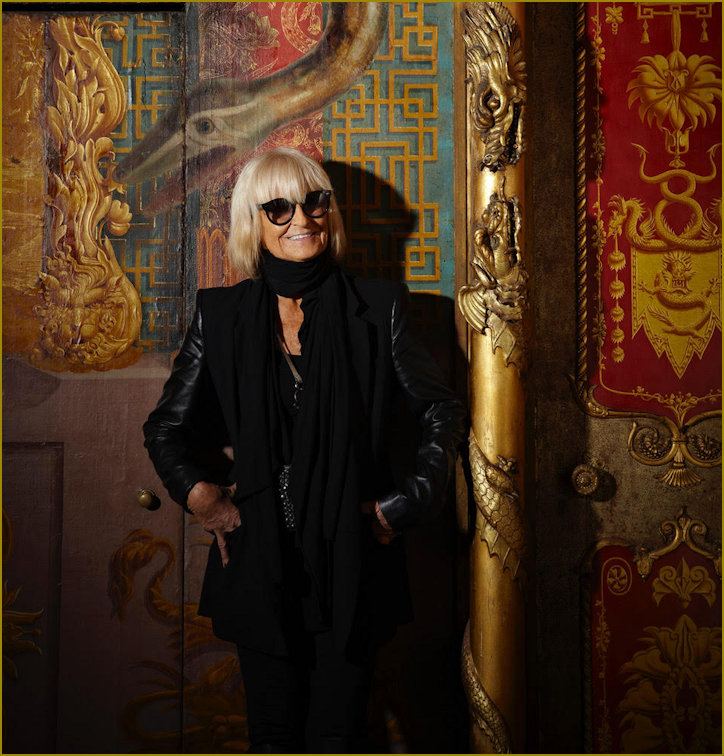
Image courtesy & © of Tessa Hallman via Stylowamoda.pl
Exclusive interview with Barbara Hulanicki“We used to be a like a bread shop, deliveries twice a day”
I have to admit that the longer I read about you by delving into different sources, the more I was intimidated and fascinated by you. From fashion icon, revolutionist and “godmother of fast fashion” as Judyta Fibiger calls you in the book “Barbara Hulanicki. Ważne jest tylko jutro”, to me you became not only sensitive, wise, entrepreneurial and inspirational woman, but a visionary and fashion mother.
Is admiration of your work tiring or does it still please you and obligates you?
I absolutely love that people appreciate Biba. There is such nostalgia for the shops.
You once said “If I rest, the rust will cover me”. What is so fascinating in the fashion industry? What gives you the strength to keep going forward?
You have to be aware everyday about the progress of the industry, especially now there is such an abundance of products and designers. It is like fishing.
I’m sure as a visionary you are wondering what the market and fashion industry will look like in the future. How do you imagine the fashion of TOMORROW?
I think it’s rather scary, as the new generation here in America does not really follow the usual fashion model. It was all about clothes before but now there is food, travel and computers, and of course home decoration.
Globalization and social transformation cause fashion to change. The pop-up retail phenomenon is a great example of it. Pop-up stores carry emotion, and that is attractive to the consumers and the media. Do you think fashion is dying or is it changing its traditional meaning? Or maybe it is adjusting to the times in which it functions?
Pop up is so transient; it makes you buy it there and then, and not “to think about it.” In the sixties the fashion changed with a new generation. That is why it was such a powerful statement. The same is happening now with the Z generation. The Internet has caught retailers napping. They believed it would just go away.
Fast fashion 50 years ago and today?
Biba was the leader in fast fashion because we manufactured locally. Today garments are sewn a million miles away and can’t be fast. We used to be a like a bread shop, deliveries twice a day.
Today, when we think of fashion availability, we usually think about consumerism and the tragic impact of ecological trace on the world, perhaps we should think of something else?
This is one of the problems for the industry now, the new generation is much more aware of the fast problems. We are still addicted to the fun of the touch and feel of shopping.
Online shops are an every-day reality. You can touch and try it on later, if you don’t like it you may sent it back. It’s a convenience and a sign of the times, what’s your take on that?
I think it is great for the customer but it is a disaster for the retailer. The products will become more expensive to pay for to cover all the returns.
Because we take less time to look for well-designed and well sewn clothes, we have less respect for them?
Not at all, that’s why we send them back (return them). You can make the clothes shapes look amazing with a bit of Photoshop.
Fashion is a risky business. The internet fashion ersatz gives young people enough satisfaction. On the other hand, today the sensory marketing based on all senses is becoming more and more important. Holistic sensory experiences are used by all the leading brands. However, how is it possible that forbidding customers from touching the clothes can increase sales, as Swedish researchers have proven?
The sales in Sweden have probably increased as people can’t be bothered to send the bad clothes back. They just rot in their wardrobes.
„Biba look” is a cult look. Can you predict what image will take over the future of fashion?
It always comes back to the filtered feminine look. As the clothes go through a crazy stage, a stage we are currently in. It’s much like the 80’s with giant proportions etc. so lovely on a young face and great figure.
For the time being, the trend for “body positive” still dominates. The famous online store ASOS has stopped retouching photos of models. Do you think love handles, cellulite, stretch marks, scars and marks will enter the beauty canons of the Photoshop-free world?
No Photoshop on models! Come on, they are using beautiful young girls to start with, not ordinary flabby ladies!
Street fashion inspires great fashion houses. Together as a society, do you think we can still be fashion creators?
Absolutely, there will always be creativity. It’s turning more to crafts as it was during the war in the UK. Then it will influence the fashion in the 70’s vintage was very cheap and plentiful and there were dressmakers galore to alter the clothes.
At the moment everything is fashionable – retro instead of innovation, innovation instead of expressive fashion, recycling undermining the authenticity of the trend. We are hearing about designers resigning from co-operation with brands “to focus on their own collections”. Among them are Albert Elbaz, Marc Jacobs, Alexander Wang and Raf Simons. Don’t you think this carousel is exhausting?
Yes, they are now doing their own collections because they were let go by the fashion houses because their collections did not make any money. It is all about money and profit now.
You have an extremely rich and exciting range of professional experience. Not only your enormous talent but also hard work revolutionized the fashion world. What advice would you give young people who want to leave their footprint in the fashion industry?
Take everything step by step. Learn from designer companies by working for them. Learn about the back of house. Work in large companies stock rooms, get a job in a department store to see all the problems and plusses, and then start your own business.
Conducting this interview was a privilege and an honor. Thank you very much for allowing me to do that. - Reporter : Izabela Jabłonowska
We found out the house used to be a brothel, recalls Barbara Hulanicki
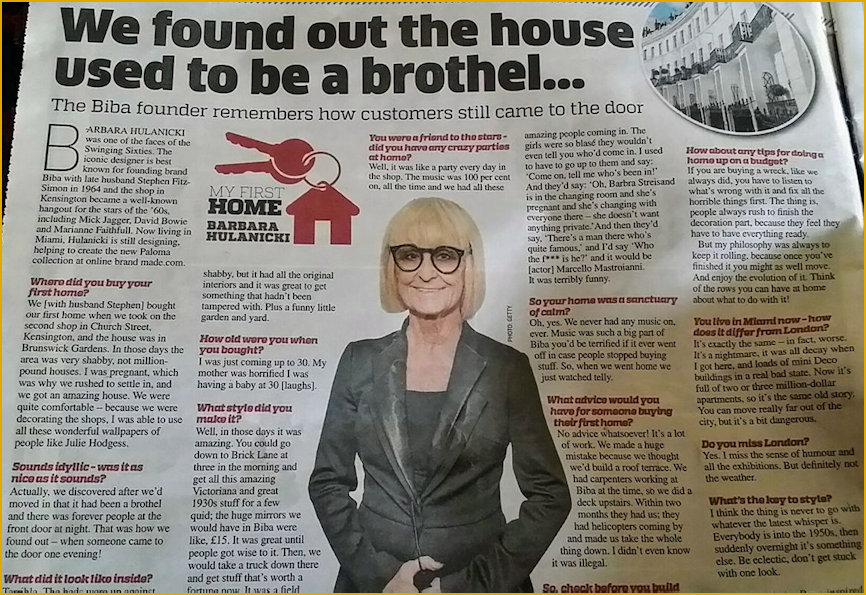
BARBARA HULANICKI was one of the faces of the Swinging Sixties. The iconic designer is best known for founding brand Biba with late husband Stephen Fitz-Simon in 1964 and the shop in Kensington became a well-known hangout for the stars of the ’60s, including Mick Jagger, David Bowie and Marianne Faithfull. Now living in Miami, Hulanicki is still designing, helping to create the new Paloma collection at online brand made.com.
Where did you buy your first home?
We [with husband Stephen] bought our first home when we took on the second shop in Church Street, Kensington, and the house was in Brunswick Gardens. In those days the area was very shabby, not million-pound houses. I was pregnant, which was why we rushed to settle in, and we got an amazing house. We were quite comfortable — because we were decorating the shops, I was able to use all these wonderful wallpapers of people like Julie Hodgess.
Sounds idyllic — was it as nice as it sounds?
Actually, we discovered after we’d moved in that it had been a brothel and there were forever people at the front door at night. That was how we found out — when someone came to the door one evening!
What did it look like inside?
Terrible. The beds were up against the big windows and weren’t in the dark area, and there was nothing to look at, I can tell you. It was very shabby, but it had all the original interiors and it was great to get something that hadn’t been tampered with. Plus a funny little garden and yard.
How old were you when you bought?
I was just coming up to 30. My mother was horrified I was having a baby at 30 [laughs].
What style did you make it?
Well, in those days it was amazing. You could go down to Brick Lane at three in the morning and get all this amazing Victoriana and great 1930s stuff for a few quid; the huge mirrors we would have in Biba were like, £15. It was great until people got wise to it. Then, we would take a truck down there and get stuff that’s worth a fortune now. It was a field where dealers would come in from all over the country, rain or shine. It was quite tough.
You were a friend to the stars — did you have any crazy parties at home?
Well, it was like a party every day in the shop. The music was 100 per cent on, all the time and we had all these amazing people coming in. The girls were so blasé they wouldn’t even tell you who’d come in. I used to have to go up to them and say: ‘Come on, tell me who’s been in!’ And they’d say: ‘Oh, Barbra Streisand is in the changing room and she’s pregnant and she’s changing with everyone there — she doesn’t want anything private.’And then they’d say, ‘There’s a man there who’s quite famous,’ and I’d say ‘Who the f*** is he?’ and it would be [actor] Marcello Mastroianni. It was terribly funny.
So your home was a sanctuary of calm?
Oh, yes. We never had any music on, ever. Music was such a big part of Biba you’d be terrified if it ever went off in case people stopped buying stuff. So, when we went home we just watched telly.
What advice would you have for someone buying their first home?
No advice whatsoever! It’s a lot of work. We made a huge mistake because we thought we’d build a roof terrace. We had carpenters working at Biba at the time, so we did a deck upstairs. Within two months they had us; they had helicopters coming by and made us take the whole thing down. I didn’t even know it was illegal.
So, check before you build something or add something?
Definitely. There are so many rules now, it’s a nightmare.
How about any tips for doing a home up on a budget?
If you are buying a wreck, like we always did, you have to listen to what’s wrong with it and fix all the horrible things first. The thing is, people always rush to finish the decoration part, because they feel they have to have everything ready. But my philosophy was always to keep it rolling, because once you’ve finished it you might as well move. And enjoy the evolution of it. Think of the rows you can have at home about what to do with it!
You live in Miami now — how does it differ from London?
It’s exactly the same — in fact, worse. It’s a nightmare, it was all decay when I got here, and loads of mini Deco buildings in a real bad state. Now it’s full of two or three million-dollar apartments, so it’s the same old story. You can move really far out of the city, but it’s a bit dangerous.
Do you miss London?
Yes. I miss the sense of humour and all the exhibitions. But definitely not the weather.
What’s the key to style?
I think the thing is never to go with whatever the latest whisper is. Everybody is into the 1950s, then suddenly overnight it’s something else. Be eclectic, don’t get stuck with one look.
Barbara speaks out in 2014
The sexual revolution has swung too far the other way with celebrities dressing like 'porn stars', says founder of iconic 1960s fashion label Biba
- Barbara Hulanicki was one of the inspirations behind Swinging Sixties
- Designer founded Biba label in the 1960s and dressed model Twiggy
- She feels liberation has gone too far with celebrities bearing lots of flesh
- Hulanicki brands trend for celebrities showing 'cleavages' similar to porn
- She is concerned by younger age when girls start taking contraceptive pill
- Hulanicki, 78, announced return to Biba at House of Fraser as a consultant
By Claire Carter for MailOnline | Published: 11:21, 14 November 2014 | Updated: 23:20, 14 November 2014
She is said to have been one of the founding figures of the Swinging Sixties. Twiggy and Bianca Jagger were among the figures Barbara Hulanicki, the fashion guru and founder of the iconic boutique Biba, dressed in the label's heyday. But now the fashion designer believes the sexual revolution has gone too far, with celebrities no longer expressing themselves through new fashion but some bearing so much flesh they resemble porn stars. Hulanicki branded some of the clothes now worn on the red carpet as 'horrible'. ‘There’s no mystery. Talk about cleavages. It’s like porn – over the top,' Hulanicki told the Daily Telegraph.
The Polish-born designer said she feels the revolution has gone too far, with young girls now taking the pill earlier than ever. She said: ‘What’s scary now is that there are very young girls taking it. They’re starting too early. It’s not about love anymore. We’ve been liberated too much.’ Ms Hulanicki said the launch of the pill in 1961 - at the start of the sexual revolution that gave women more freedom to express themselves - was welcome at the time. She said women began to be aware of their own shape and were no longer forced to live in what she described as 'hormonal hell.'
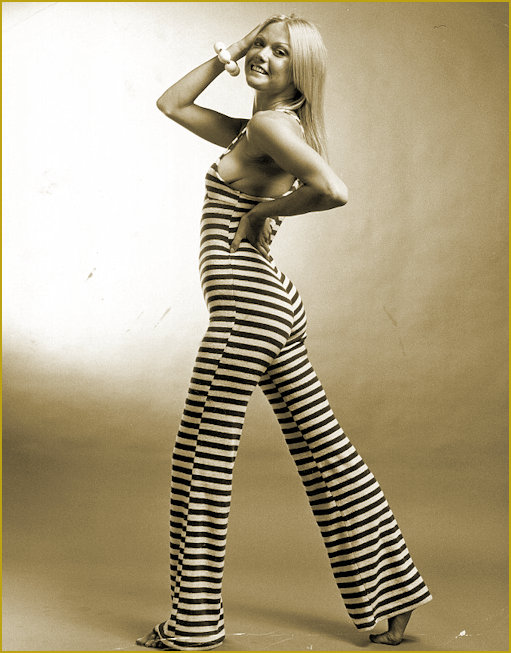
A 1969 Biba playsuit was seen as an item to be worn by the 'bold' because of deep cut armholes and neckline
Ms Hulanicki admitted she took the pill herself, something which she felt gave her a 'happier life' and husband. The 78-year-old this week announced her return to Biba, now owned by House of Fraser, after decades of absence. Ms Hulanicki launched a fashion mail-order company in 1963 with her husband Stephen Fitz-Simon. The label was relaunched four years ago by the department store and Hulanicki will now work as a consultant. She launched the firm, which began as a mail order fashion business before opening its first store in London, 50 years ago with her husband Stephen Fitz-Simon. Biba became known for its daring fashion and helped to define some of the clothes in the swinging sixties.
Ms Hulanicki is now an interior designer in Miami after losing control of her company name in the seventies.

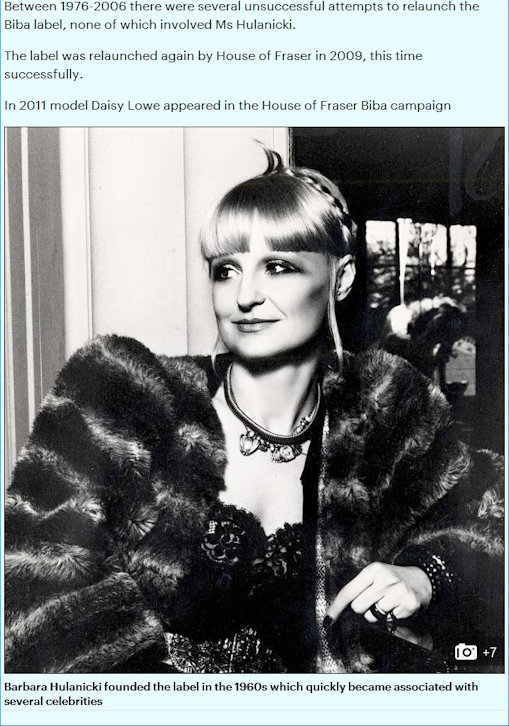
Biba Attack - 2013
From the Daily Mail dated 20th June 2013
Today's women dress so badly because they all follow fashion, says founder of 60s label Biba
Barbara Hulanicki, 77, founded Biba in the 1960s and is still a consultant
She believes excessive interest in clothes makes women dress less well
Says high streets are saturated with shops selling near-identical clothes
By Laura Cox PUBLISHED: 23:52, 19 June 2013 | UPDATED: 07:43, 20 June 2013
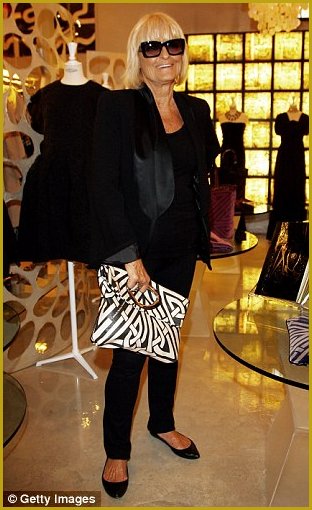 She brought mini-skirts and psychedelic colours to 60s shoppers, used Twiggy as the face of her clothing range and founded a label that is still the red carpet choice of stars such as Jennifer Lopez.
She brought mini-skirts and psychedelic colours to 60s shoppers, used Twiggy as the face of her clothing range and founded a label that is still the red carpet choice of stars such as Jennifer Lopez.
But despite the influence she has had on the world of fashion, Barbara Hulanicki thinks modern women dress badly – because following fashion makes them all look the same.
The 77-year-old designer, who founded Biba in the 1960s and is still a consultant for retailers in both the US and UK, said: ‘There’s too much interest in clothes now and it makes women dress less well.
'I think people are too concerned about what’s fashionable. Women have such boring wardrobes these days because they must follow fashion, they must, they must. But sometimes it’s about saying, oh, this would work well with that.’
Miss Hulanicki, who last year was awarded an OBE for services to the fashion industry, acknowledged it is now harder to dress interestingly because high streets are saturated with shops selling near-identical clothes.
Biba founder: Barbara Hulanicki thinks modern women dress badly - because following fashion makes them all look the same She said: ‘It’s very difficult to know what to wear now. That’s why I always wear black.’
Biba began as a cheaply priced mail-order business in 1963 before growing rapidly over the next decade and taking over a seven-floor department store. Rock and film stars including Mick Jagger and David Bowie used to hang out in the store, which had promotional campaigns fronted by Twiggy. Anna Wintour, who would go on to become the editor of American Vogue, began her fashion career working for Biba as a 15-year-old.
The brand re-launched in 2010, channelling its heritage by showing model Daisy Lowe in a 60s-inspired shoot. Speaking at a signing event for her new book, Seamless, in an East London vintage store, Miss Hulanicki also singled out American women as the worst dressers, adding: ‘They’re terrible; they all wear the same thing.’
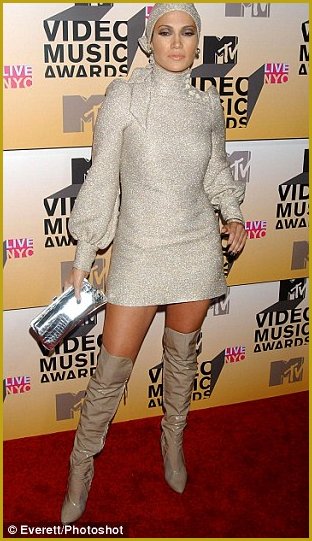

Still popular: A Biba dress worn by Jennifer Lopez, left, in 2006. Right, Twiggy promotes Biba in 1972 - Images copyright as shown - Everett/Photoshoot and Getty Images
Pastures New - 2010
BARBARA HULANICKI'S split from Biba may have been difficult but she's putting it all behind her.
From Vogue: 13 October 2010
"It was very painful when it all first happened," she admits. "I had to go away to get myself back together and of course I miss all the designers terribly. But I have a new life now. I like living in America because everyone looks to the future, they don't look back all the time."
Hulanicki, who recently dismissed the House of Fraser's Biba relaunch, is about to launch a new collection for George at Asda.
"The thing I didn't like about the new Biba relaunch was the prices - it is too expensive," she says. "With Asda it's the total opposite - it's like the old days in the Sixties. I love seeing people happily shopping without feeling guilty because they've spent too much. I want to do what I always have done - make clothes for young people living in bedsits. What was different about designing for Asda was creating pieces that go up to size 20. I had to do things in a different way - it was exciting."
Despite setting up the iconic Biba label in the Sixties, Hulanicki confesses that it wasn't all free love, peace and harmony.
"Actually me and all the designers of the time, like Zandra Rhodes and Mary Quant, all hated each other," she tells us. "We definitely didn't talk to each other, everyone was too busy making dresses. It was very basic and raw in those days. Parties were for musicians, not fashion designers."
How has the industry changed since she first began her career?
"What is different now is how designers have to come up with completely new ideas every time they show their collections," she says. "It must be terribly difficult. When Biba first opened we moved very fast and there was never enough to stock because our customers were always so hungry, but there was never this massive shift from autumn/winter to spring/summer that there is today. You would change the chiffon summer dresses to coats and jackets but your style would still be the same. It was a much simpler way of working."
From an article in Vogue by Ella Alexander dated 30th September 2010
 BARBARA HULANICKI has dismissed the House of Fraser's newly relaunched Biba label. The designer, who originally founded Biba, lost control of her business in 1975 and is now planning on launching a line for Asda this November.
BARBARA HULANICKI has dismissed the House of Fraser's newly relaunched Biba label. The designer, who originally founded Biba, lost control of her business in 1975 and is now planning on launching a line for Asda this November.
"I always find everyone who buys it [the Biba trademark] thinks of it as couture, but I think it is more like Woolworths - which is what it was always meant to be," says Hulanicki. "[The House of Fraser collection] is too expensive. The prices [at Asda] are just amazing. These will really be Biba prices. F*** you [House of Fraser]."
Does she think the new House of Fraser line reflects Biba's Sixties aesthetic?
"No," she reveals. "It looks like House of Fraser. No comment," she tells Drapers.
Hulanicki's new range for George at Asda will comprise 12 styles and will be the first of four collections.
Being Barbara - 2009
From an article in Vogue by Jessica Bumpus dated 27th October 2009
She's the woman behind the Sixties-Seventies phenomenon that was Biba and last night Barbara Hulanicki let us into her creative world at a screening of the new documentary film in which she stars, Beyond Biba.
"Barbara has always been an extraordinary influence in my life. I had no idea fashion existed in that way. She was one of the reasons I got into fashion. Somehow she made that fantasy functional," milliner Stephen Jones, who introduced the film to a fashion student-filled Cochrane Theatre at Central Saint Martins, explained.
Documenting Hulanicki's life from her childhood, her drawing, her husband Fitz, the Biba shops and her move into interior design, the film is as a result of its director Louis Price's own experience of Biba. "My mother used to work for Biba so I grew up with all this Biba imagery and read Barbara's autobiography A To Biba and thought it would make an amazing documentary," said Price, a former Central Saint Martins graduate himself.
Sidestepping fashion for illustration because "to get into fashion you had to spend ages picking up pins" and because she "wanted to get on with it", Hulanicki found herself working at The Times doing editorial illustration, which in turn took her to the shows, where she wasn't all that impressed. "I used to hate all of those clothes - they weren't for young people, they were for women who went to lunch all the time so I really wanted to design for young people." And Biba was born.
Barbara's Life and Comments
On the spirit of Biba:
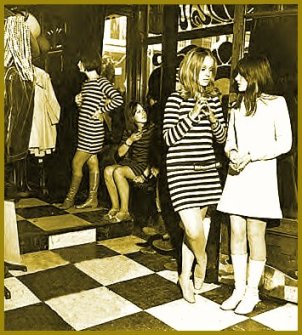
"I was terribly into films and film sets so I thought of the sets first and then what clothes should be in there. With each shop, we did a different decade. I was brought up with Garbo films and all these dresses flowing around the body – Queen Christina and Esther Williams films. Colour was so important."
On the Biba name:
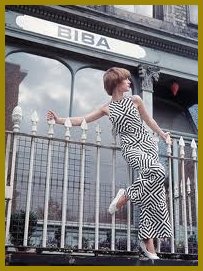
"Fitz [her late husband and co-founder of Biba] said you've got to come up with a name by tomorrow and I said what about Biba and he said it sounded good. I tried it out the following day on a Russian Prince" – whose unimpressed response was exactly what Hulanicki was after. That and "It's a nickname for one of my sisters."
On the Biba Vision
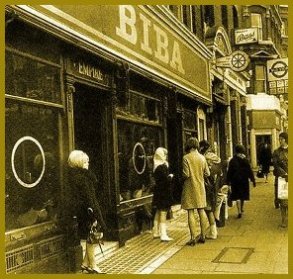
"It definitely grew and everything that went in there were the things we needed. When we had a baby, we did baby clothes, then we did homeware and then there was a food department. It was all from the heart. Today it's so different, you have to work out your market."
On 'Architecture versus Fashion'
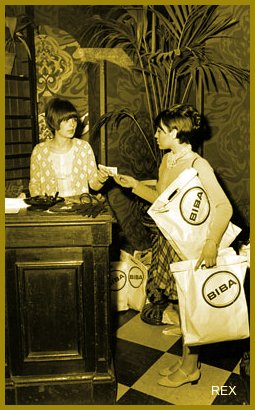
Photograph courtesy of Rex Features
"It's very nice hopping from one thing to another." But if she had to choose? "Clothes, fashion, you get hooked on that."
No wonder Barbara chose fashion:
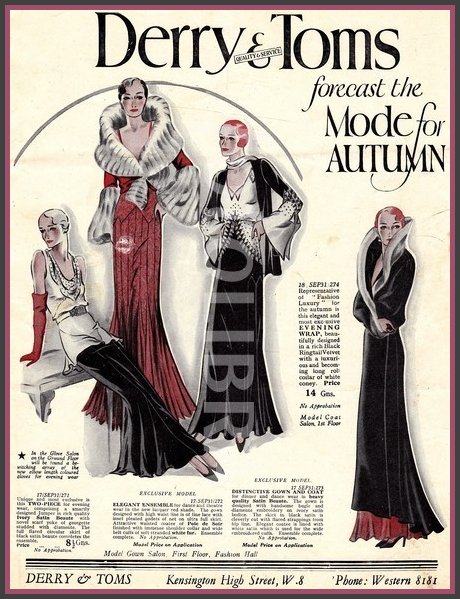
I think I would have chosen fashion as well!
Page updated : 2nd August 2017
